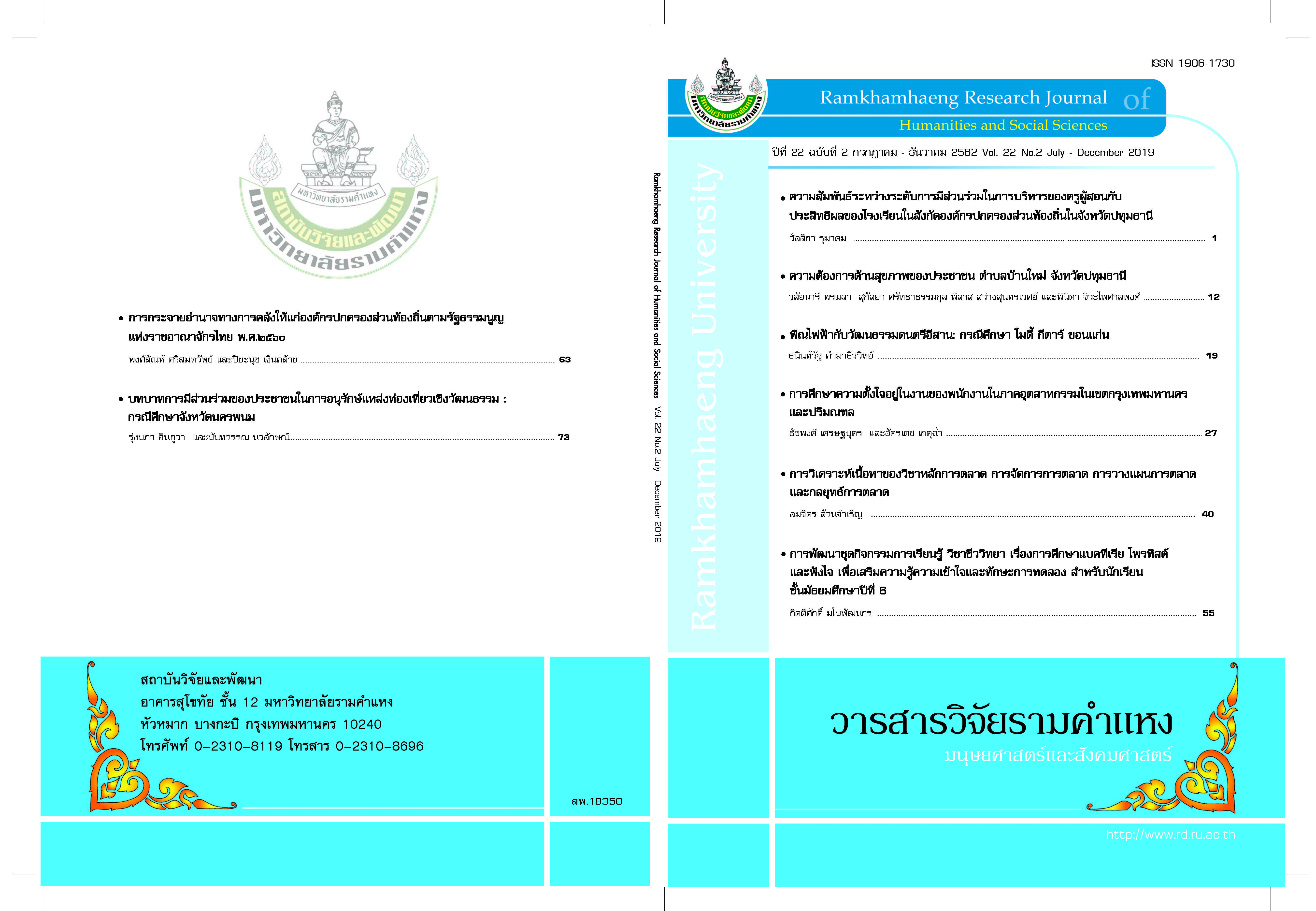A Study of Industrial Sector Employees’ Intention to Stay in the Bangkok Metropolitan Region
Main Article Content
Abstract
In this descriptive research, the researchers have two objectives: study the level of the intention to stay of employees in the industrial sector of the Bangkok Metropolitan Region; and compare the level of intention to stay of the employees in various departments in the organizations under study. The sample population consisted of 325 employees working in departments of organizations in the industrial sector of the Bangkok Metropolitan Region. The research instruments consisted of a questionnaire on demographic data and a questionnaire eliciting the intention to stay. Data were descriptively analyzed using frequency, percentage, mean, and standard deviation. The analysis of variance was also employed. Findings are as follows: 1. The level of the intention of the employees under study to stay exhibited the mean of 4.32, which was at a moderate level. 2. The comparison of the level of the intention to stay of the employees in various departments in the organizations was found to exhibit differences in the means of the intention to stay
at the statistically significant level of 0.05.
Article Details
ใส่ข้อความกอปปี้ไรท์
References
ศีลบุตร และยุวนุช สัตยสมบูรณ์. 2561. ความตั้งใจคงอยู่ในองค์การของบุคลากรสายงานหลักกรมการแพทย์ไทยและการแพทย์ทางเลือกกระทรวงสาธารณสุข. วารสารสาธารณสุขศาสตร์. 48(3). 308-318.
กองเศรษฐกิจแรงงาน สำนักงานปลัดกระทรวงแรงงาน. 2562. เศรษฐกิจแรงงาน ประจำเดือน 2561. สืบค้นเมื่อ 14 มิถุนายน 2562 จากhttp://warning.mol.go.th/uploadFile/pdf/pdf-2019-01-29-1548741821.pdf.
จ๊อบท๊อบกันดอทคอม. 2560. มาทำความรู้จักสายงาน “HR” ในปัจจุบัน. สืบค้นเมื่อ 20 มิถุนายน 2562 จาก https://www.jobtopgun.com/ผู้หางาน/มารู้จักสายงานhr
จ๊อบดีบีดอทคอม. (2561). ลักษณะและขอบเขตของงานการบริหารทรัพยากรมนุษย์ (Human Resource management). สืบค้นเมื่อ 20 มิถุนายน 2562 จาก https://th.jobsdb.com/th-th/articles/hrm
ธัชพงศ์ เศรษฐบุตร. 2562. การจัดการผลการปฏิบัติงาน. กรุงเทพฯ: ทริปเพิ้ล กรุ๊ป.
ธเนศ ปทุมานนท์, สุชนนี เมธิโยธิน และบรรพรต
วิรุณราช. 2560. โมเดลสมการโครงสร้างความตั้งใจคงอยู่ในงานพยาบาลวิชาชีพโรงพยาบาลศูนย์สังกัดสำนักงานปลัดกระทรวงสาธารณสุข. วารสารบัณฑิตศึกษา มหาวิทยาลัยราชภัฏวไลยอลงกรณ์ ในพระบรมราชูปถัมภ์. 11(3). 81-96.
ถิตรัตน์ พิมพาภรณ์ และวิโรจน์ เจษฎาลักษณ์. 2559. อิทธิพลของคุณภาพชีวิตในการทำงานที่มีต่อความตั้งใจคงอย่ในงานผ่านความผูกพันในอาชีพของอาจารย์สถาบันอุดมศึกษาในกำกับของรัฐแห่งหนึ่ง. วารสารอิเล็กทรอนิกส์การเรียนรู้ทางไกลเชิงวัฒนธรรม. 6(1). 114-132.
นลินรัตน์ ทองนิรันดร์, ภูษิตา อินทรประสงค์ และจรรยา ภัทรอาชาชัย. 2558. ความตั้งใจคงอยู่ในอาชีพของพยาบาลวิชาชีพ โรงพยาบาลชุมชน เขต 1 ภาคกลาง ประเทศไทย. วารสารกองการพยาบาล. 42(3). 69-83.
นิศาชล ภูมิพื้นผล. 2559. ปัจจัยที่มีอิทธิพลต่อการคงอยู่ในงาน : กรณีศึกษา บริษัท เดลแมกซ์ แมชินเนอรี่ จำกัด. การศึกษาอิสระหลักสูตรบริหารธุรกิจมหาบัณฑิต วิชาเอกการจัดการวิศวกรรมธุรกิจ, มหาวิทยาลัยเทคโนโลยีราชมงคงธัญบุรี.
นฤมล นุ้ยรัตน์ และกัญญดา ประจุศิลป. 2561. ความสัมพันธ์ระหว่างปัจจัยส่วนบุคคล สมดุลชีวิตกับการทำงาน การสนับสนุนจากองค์การกับความตั้งใจคงอยู่ในงานของพยาบาลผู้มีประสบการณ์ โรงพยาบาลเอกชนที่ผ่านการรับรองโรงพยาบาลมาตรฐานสากลกรุงเทพมหานคร. วารสารพยาบาลทหารบก. 19 (ฉบับพิเศษ). 149-157.
บีแอลทีแบงค็อกดอทคอม. 2561. แรงงานไทยยุค 4.0. สืบค้นเมื่อ 9 มิถุนายน 2562 จาก http://www.bltbangkok.com/article/info/29/593
บุญช่วย ศิลาหม่อม, วรรณี เดียวอิสเรศ และอารีรัตน์ ขำอยู่. 2561. ปัจจัยที่มีอิทธิพลต่อการคงอยู่ในงานของพยาบาลวิชาชีพ Generation Y โรงพยาบาลแห่งหนึ่ง. วารสารการพยาบาลและการดูแลสุขภาพ. 36(1). 62-71.
ศรัณย์ พิมพ์ทอง. 2557. ปัจจัยเชิงสาเหตุที่มีอิทธิพลต่อการคงอยู่ในองค์การของพนักงานมหาวิทยาลัยสายวิชาการในประเทศไทย. วารสารบริหารธุรกิจ. 37(142). 16-32.
สิริพิมพ์ ชูปาน, อารีรัตน์ ขำอยู่, ศิริวัลห์ วัฒนสินธุ์ และดวงใจ วัฒนสินธุ์. 2560. ปัจจัยที่มีอิทธิพลต่อความตั้งใจคงอยู่ในงานของพยาบาลวิชาชีพ. วารสารคณะพยาบาลศาสตร์ มหาวิทยาลัยบูรพา. 25(4). 1-10.
สุรีรัตน์ จิตเพิ่มสุข. 2554. ปัจจัยที่มีอิทธิพลต่อความพึงพอใจในงานของพนักงานฝ่ายผลิต: กรณีศึกษา บริษัท แคนนอน ไฮเทค (ประเทศไทย) จำกัด. การค้นคว้าอิสระตามหลักสูตรบริหารธุรกิจมหาบัณฑิต คณะบริหารธุรกิจ มหาวิทยาลัยเทคโนโลยีราชมงคลธัญบุรี.
อรุณรุ่ง เอื้ออารีสุขสกุล และธีระวัฒน์ จันทึก. 2558. การบริหารจัดการคนเก่งเชิงกลยุทธ์: ปัจจัยสำคัญสู่ความได้เปรียบทางการแข่งขันอย่างยั่งยืน. Veridian E-Journal. 8(3). 1096-1112.
เอกอนงค์ ศรีสำอางค์ และปิยะนุช เงินคล้าย. 2559. การธำรงรักษาอาจารย์ในสถาบันอุดมศึกษาไทย: กรณีศึกษามหาวิทยาลัยในเขตกรุงเทพมหานคร. บัณฑิตวิทยาลัย มหาวิทยาลัยสวนดุสิต. 12(3). 153-170.
Abbasi, S.M. and Hollman, K.W. 2000. Turnover: The Real Bottom Line. Public Personnel Management. 29(3). 333-342.
Adecco. 2562. Thailand Salary Guide 2019. Retrieved June 20, 2019, from https://adecco.co.th/salary-guide
Ampomah, P. and Cudjor, S.K. 2015. The Effect of Employee Turnover on Organizations (Case Study of Electricity Company of Ghana, Cape Coast). Asian Journal of Social Sciences and Management Studies. 2(1). 21-24.
Brown, S.P. 2008. Business Processes and Business Functions: a new way of looking at employment. Monthly Labor Review. 131(4). 51-70.
Chaisuriyathavikun, M. and Punnakitikashem, P. 2015. A Study of Organizational Commitment and Intention to Stay in Gold Retailer Business. International Journal of Management and Applied Science. 1(2). 1-5.
Choi, S.L., Perumal, P., and Ajagbe, M.A. 2012. The Impact of Human Resource Management Practices on Employees’ Turnover Intention: A Conceptual Model. Interdisciplinary Journal of Contemporary Research in Business. 4(2). 629-641.
Faul, F., Erdfelder, E., Buchner, A., and Lang, A.G. 2009. Statistical power analyses using G*Power 3.1: Tests for correlation and regression analyses. Behavior Research Methods. 41. 1149-1160.
Geenberg, J. 2013. Managing Behavior in Organizations 6th Ed. Boston: Pearson.
Ghosh, P., Satyawadi, R., Joshi, J.P. and Shadman, M. 2012. Who stays with you? Factors predicting employees’ intention to stay. International Journal of Organizational Analysis. 21(3). 288-312.
Johnson, J., Griffeth, R.W. and Griffin, M. 2000. Factors discrimination functional and dysfunctional sales force turnover. Journal of Business & Industrial Marketing. 15(6), 399-415.
Kossivi, B., Xu, M. and Kalgora, B. 2016. Study on Determining Factors of Employee Retention. Open Journal of Social Sciences.
4. 261-268.
Medina, E. 2012. Job satisfaction and employee turnover intention: what does organizational culture have to do with it? (Doctoral dissertation). New York: Columbia University.
Menezes, I., Lozado, J., Menezes, A. C., Moraes, E., Sandbrand, D., Muszynski, P., & Ruggeri, K. 2018. Development and validation of the Multidimensional Turnover Intentions Scale. British Academy of Management Conference 2018. Bristol: United Kingdom.
Nanncarrow, S., Bradbury, J., Pit, S. W., & Ariss, S. 2014. Intention to stay and intention to leave: are they two sides of the same coin? A cross-sectional structural equation modelling study among health and social care workers. Journal of occupational health. 56. 14-0027.
Nielsen, P.B. (2012). Towards a Definition of Business Functions. Unsd/ESCwa Regional Seminar on International Trade Statistics. June 12-14: Jordan.
Nor, N.B.. (2012). Turnover Intention: An Examination of Job Characteristics and Transactional Leadership Style among Operators in Electrical and Electronics Sub-Sector (Master Thesis). Universiti Utara. Malaysia.
Zaki, M.A., Hunssien, H.S., Sanad, H.M. and EI-Khoriby, S.S. 2015. Analyzing Organizational Structure for Contracting Firms’ of Classification “A”, Egypt. Journal of Engineering Sciences. 43(3). 403-428.


